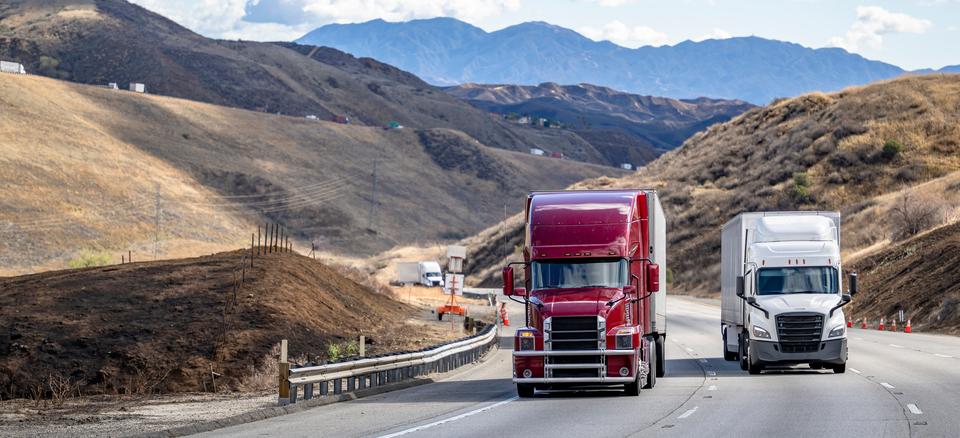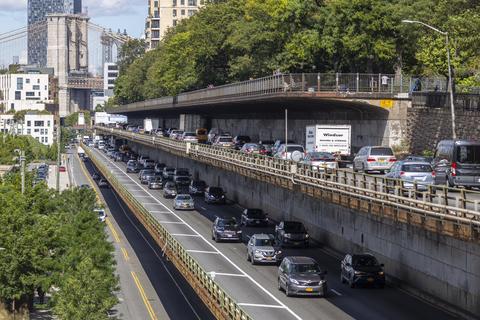
Introduction
According to the 2021 Fact Sheet: The Bipartisan Infrastructure Deal, one in five miles of U.S. highways and major roads and over 45,000 bridges are in poor condition. A major contributor to road damage stems from heavy or excess weight vehicles – or to be more precise – the heavy axle loads of these vehicles onto the road surface and/or pavement. As claimed by an article of Inside Science, this damage grows exponentially with the axle load of the vehicle. For comparison, a 40-ton commercial truck with 8 axles causes 625 times more road damage than a 2-ton passenger sedan with 2 axles.
The Brooklyn-Queens Expressway (BQE) is a heavily used highway that comprises a critical link of I-278 – the sole Interstate highway in Brooklyn that connects Manhattan, Staten Island, and Queens in New York. Regionally, it is also the only freight route into the New York City (NYC) area from New Jersey to the south through Staten Island and a vital freight route for Nassau and Suffolk Counties. This portion of BQE was completed in 1954; parts of the expressway are at the end of their design life and in a deteriorating state.
While urgent repairs are underway to protect this critical piece of infrastructure, additional means to slow down further deterioration needed to be identified. The New York State legislature authorized the NYC Department of Transportation (NYCDOT) to conduct automated overweight vehicle enforcement through a weigh-in-motion system demonstration program on this section of the BQE in 2021.
Enforcement of vehicle weight limits

While urgent repairs are underway to protect this critical piece of infrastructure, additional means to slow down further deterioration needed to be implemented. Vehicles that are liable to exceed the road weight limit are traditionally guided off the road to a location nearby and weighed on a static scale. This can be a dedicated weigh station or a location where the vehicle is weighed on portable wheel-load weighers.
However, there are no suitable weigh stations near the troubled section of the BQE, and due to the dense construction in NYC, there is insufficient space to pull a truck over to weigh it on a portable scale. Therefore, NYCDOT decided to implement an automatic weigh-in-motion (WIM) system to weigh vehicles while they travel over the BQE.
Weighing instruments that are used in New York State for law enforcement purposes (i.e., vehicle scales and wheel load weighers) are regulated through NIST Handbook 44. Since these high-speed WIM systems, like the one installed on the BQE, are not covered by NIST Handbook 44, New York City is unable to use them through the existing law enforcement legislation.
In 2021, the New York State legislature authorized the NYCDOT to conduct automated overweight vehicle enforcement on the troubled section of the BQE through a weigh-in-motion system demonstration program. This demonstration program provides a temporary legislative basis for enforcement of the BQE weight limits while efforts are made to add WIM systems for law enforcement in NIST Handbook 44.
Adoption in NIST Handbook 44
NIST Handbook 44 Section 2.25 currently contains tentative code for Weigh-In-Motion systems used for screening purposes. Under this code, overweight vehicles can be detected using a WIM system, but the weighing result cannot be used for issuing a citation. In order to issue a citation, the law enforcement officer needs to pull the truck driver over to reweigh the vehicle statically. This procedure is not suitable for the situation at the BQE since there is no space to pull violators over.
In August 2022, the NYCDOT, C2SMART (U.S. Department of Transportation Tier 1 University Transportation Center), and Kistler (manufacturer of the BQE WIM system) submitted a proposal to NCWM to amend NIST Handbook 44. The proposal provided a model code for WIM systems that are used for direct enforcement applications (i.e., enforcement where the weighing results generated by WIM systems can be used to issue citations to violators).
After two years and several iterations of the proposal, the item will be up for voting in July during the 2024 NCWM Annual meeting. If adopted, the code will be included in the 2025 edition of NIST Handbook 44. This will give New York State the opportunity to bring the regulation of WIM systems under their regular Weights and Measures legislation.
NIST Special Publication 2200-05
As part of its Legal Metrology 2200 publication series, OWM has recently published NIST Special Publication SP 2200-05 Certification Approaches for Weigh-In-Motion Systems in Law Enforcement Applications, which serves as guidance to all stakeholders involved with the application of WIM systems for direct enforcement of road weight limits.
NIST SP 2200-05 discusses the differences between WIM systems used for commercial applications and WIM systems used for law enforcement. WIM systems may come in different forms using different technologies (load cells or piezo sensors). But with the current technology, there is always a trade-off between speed and accuracy. A WIM system used for commerce is accurate but can only handle low-speed traffic. A WIM system used for law enforcement can handle vehicles traveling at high speed but is less accurate. Each application of WIM systems has its own criteria and usage. The main conclusion is that WIM systems for law enforcement cannot be compared to WIM systems for commercial applications or vice versa.
Currently, WIM systems using road sensors (often used for high-speed enforcement applications) do not fit under any of the sections in NIST Handbook 44. Although NIST Handbook 44 is the preferred documentary standard to be used for legal metrology, states have the authority to use other documentary standards. NIST SP 2200-05 discusses four internationally recognized standards for WIM systems (OIML R 134, ASTM E1318, COST 323, and NMi International WIM Standard) and their suitability.
NIST SP 2200-05 also describes how New York State Department of Weights and Measures and NYCDOT have implemented direct enforcement on the BQE in their legislation and how the certification of this system has been accomplished. This may provide guidance to other states that are exploring the use of WIM systems in their jurisdictions.
Over the last two years, several stakeholders from both industry and regulatory offices have expressed concerns about the proposal that was submitted to the NCWM for amendment of NIST Handbook 44. NIST OWM has carefully taken these concerns into consideration to verify that the submitted proposal is technically sound. NIST SP 2200-05 contains an analysis of the most frequently expressed concerns from the weights and measures community.
Acknowledgments and Further Information
NIST OWM would like to thank Tanvi Pandya of the New York City Department of Transportation (NYCDOT) for contributions related to implementation of the WIM system to enforce weight limits on the BQE, and James Willis of the New York State Department of Agriculture and Markets for a perspective on WIM systems in weights and measures applications and within the state-level regulatory environment.
NIST SP 2200-05, together with other publications in the legal metrology series, can be downloaded from the NIST OWM website here. For further information regarding this publication or WIM systems, please contact Jan Konijnenburg, Scientific Engineer (jan.konijnenburg [at] nist.gov (jan[dot]konijnenburg[at]nist[dot]gov)) or Loren Minnich, Weights and Measures Coordinator (loren.minnich [at] nist.gov (loren[dot]minnich[at]nist[dot]gov)). For general information, please contact OWM at owm [at] nist.gov (owm[at]nist[dot]gov).

